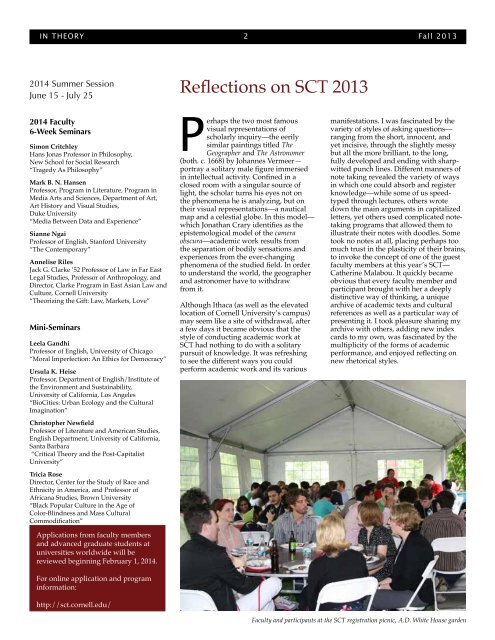to read our newsletter. - The School of Criticism and Theory - Cornell ...
to read our newsletter. - The School of Criticism and Theory - Cornell ...
to read our newsletter. - The School of Criticism and Theory - Cornell ...
Create successful ePaper yourself
Turn your PDF publications into a flip-book with our unique Google optimized e-Paper software.
IN THeory 2 Fall 20132014 Summer SessionJune 15 - July 25Reflections on SCT 20132014 Faculty6-Week SeminarsSimon CritchleyHans Jonas Pr<strong>of</strong>essor in Philosophy,New <strong>School</strong> for Social Research“Tragedy As Philosophy”Mark B. N. HansenPr<strong>of</strong>essor, Program in Literature, Program inMedia Arts <strong>and</strong> Sciences, Department <strong>of</strong> Art,Art His<strong>to</strong>ry <strong>and</strong> Visual Studies,Duke University“Media Between Data <strong>and</strong> Experience”Sianne NgaiPr<strong>of</strong>essor <strong>of</strong> English, Stanford University“<strong>The</strong> Contemporary”Annelise RilesJack G. Clarke ’52 Pr<strong>of</strong>essor <strong>of</strong> Law in Far EastLegal Studies, Pr<strong>of</strong>essor <strong>of</strong> Anthropology, <strong>and</strong>Direc<strong>to</strong>r, Clarke Program in East Asian Law <strong>and</strong>Culture, <strong>Cornell</strong> University“<strong>The</strong>orizing the Gift: Law, Markets, Love”Mini-SeminarsLeela G<strong>and</strong>hiPr<strong>of</strong>essor <strong>of</strong> English, University <strong>of</strong> Chicago“Moral Imperfection: An Ethics for Democracy”Ursula K. HeisePr<strong>of</strong>essor, Department <strong>of</strong> English/Institute <strong>of</strong>the Environment <strong>and</strong> Sustainability,University <strong>of</strong> California, Los Angeles“BioCities: Urban Ecology <strong>and</strong> the CulturalImagination”Chris<strong>to</strong>pher NewfieldPr<strong>of</strong>essor <strong>of</strong> Literature <strong>and</strong> American Studies,English Department, University <strong>of</strong> California,Santa Barbara“Critical <strong>The</strong>ory <strong>and</strong> the Post-CapitalistUniversity”Tricia RoseDirec<strong>to</strong>r, Center for the Study <strong>of</strong> Race <strong>and</strong>Ethnicity in America, <strong>and</strong> Pr<strong>of</strong>essor <strong>of</strong>Africana Studies, Brown University“Black Popular Culture in the Age <strong>of</strong>Color-Blindness <strong>and</strong> Mass CulturalCommodification”Applications from faculty members<strong>and</strong> advanced graduate students atuniversities worldwide will bereviewed beginning February 1, 2014.For online application <strong>and</strong> programinformation:http://sct.cornell.edu/Perhaps the two most famousvisual representations <strong>of</strong>scholarly inquiry—the eerilysimilar paintings titled <strong>The</strong>Geographer <strong>and</strong> <strong>The</strong> Astronomer(both. c. 1668) by Johannes Vermeer—portray a solitary male figure immersedin intellectual activity. Confined in aclosed room with a singular s<strong>our</strong>ce <strong>of</strong>light, the scholar turns his eyes not onthe phenomena he is analyzing, but ontheir visual representations—a nauticalmap <strong>and</strong> a celestial globe. In this model—which Jonathan Crary identifies as theepistemological model <strong>of</strong> the cameraobscura—academic work results fromthe separation <strong>of</strong> bodily sensations <strong>and</strong>experiences from the ever-changingphenomena <strong>of</strong> the studied field. In order<strong>to</strong> underst<strong>and</strong> the world, the geographer<strong>and</strong> astronomer have <strong>to</strong> withdrawfrom it.Although Ithaca (as well as the elevatedlocation <strong>of</strong> <strong>Cornell</strong> University’s campus)may seem like a site <strong>of</strong> withdrawal, aftera few days it became obvious that thestyle <strong>of</strong> conducting academic work atSCT had nothing <strong>to</strong> do with a solitarypursuit <strong>of</strong> knowledge. It was refreshing<strong>to</strong> see the different ways you couldperform academic work <strong>and</strong> its variousmanifestations. I was fascinated by thevariety <strong>of</strong> styles <strong>of</strong> asking questions—ranging from the short, innocent, <strong>and</strong>yet incisive, through the slightly messybut all the more brilliant, <strong>to</strong> the long,fully developed <strong>and</strong> ending with sharpwittedpunch lines. Different manners <strong>of</strong>note taking revealed the variety <strong>of</strong> waysin which one could absorb <strong>and</strong> registerknowledge—while some <strong>of</strong> us speedtypedthrough lectures, others wrotedown the main arguments in capitalizedletters, yet others used complicated notetakingprograms that allowed them <strong>to</strong>illustrate their notes with doodles. Some<strong>to</strong>ok no notes at all, placing perhaps <strong>to</strong>omuch trust in the plasticity <strong>of</strong> their brains,<strong>to</strong> invoke the concept <strong>of</strong> one <strong>of</strong> the guestfaculty members at this year’s SCT—Catherine Malabou. It quickly becameobvious that every faculty member <strong>and</strong>participant brought with her a deeplydistinctive way <strong>of</strong> thinking, a uniquearchive <strong>of</strong> academic texts <strong>and</strong> culturalreferences as well as a particular way <strong>of</strong>presenting it. I <strong>to</strong>ok pleasure sharing myarchive with others, adding new indexcards <strong>to</strong> my own, was fascinated by themultiplicity <strong>of</strong> the forms <strong>of</strong> academicperformance, <strong>and</strong> enjoyed reflecting onnew rhe<strong>to</strong>rical styles.Faculty <strong>and</strong> participants at the SCT registration picnic, A.D. White House garden


